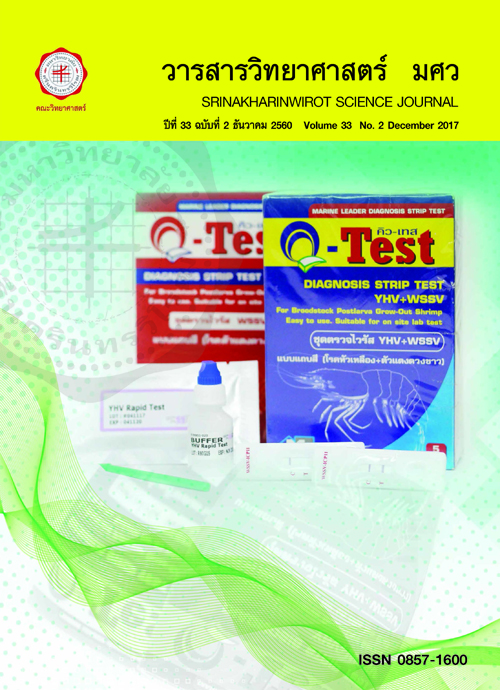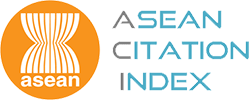การจัดกลุ่มและวิเคราะห์ความหลากหลายทางพันธุกรรมของแตงเทศและแตงไทยพันธุ์เศรษฐกิจด้วยเทคนิคทางอณูชีววิทยา
Keywords:
Cucumis, ITS region, neighbor joining method, haplotypeAbstract
บทคัดย่อ แตงเทศ (Cucumis melo L.) เป็นพืชเศรษฐกิจที่มีมูลค่าสูง โดยพันธุ์เศรษฐกิจที่นิยมปลูกมี 3 พันธุ์ ได้แก่ C. melo var. cantalupensis, C. melo var. inodorus และ C. melo var. reticulatus ในการปลูกแตงเทศเกษตรกรต้องนำเข้าเมล็ดพันธุ์ซึ่งมีราคาสูงจากต่างประเทศ ปัจจุบันจึงได้มีการทดลองปลูกแตงเทศพันธุ์ปลูกต่าง ๆ และปรับปรุงพันธุ์โดยการผสมข้าม งานวิจัยนี้จึงมีวัตถุประสงค์เพื่อวิเคราะห์ความหลากหลายทางพันธุกรรมของแตงเทศและแตงไทยพันธุ์เศรษฐกิจจำนวน 18 พันธุ์ปลูกจากทวีปเอเชีย อเมริกา และออสเตรเลีย โดยได้เพิ่มขยายปริมาณดีเอ็นเอบริเวณ internal transcribed spacer (ITS) และหาลำดับนิวคลีโอไทด์ ผลการจัดกลุ่มแตงเทศและแตงไทยด้วยวิธี neighbor joining พบการจัดกลุ่มแบ่งเป็น 12 กลุ่ม โดยพบว่า Mi Wang มีความแปรผันทางพันธุกรรมสูงที่สุด นอกจากนี้การวิเคราะห์ความสัมพันธ์ของแฮโพลไทป์ระหว่างกลุ่มของแตงเทศและแตงไทยยังยืนยันว่า Mi Wang มีฐานพันธุกรรมของบริเวณ ITS ที่กว้างที่สุด โดยมีแอลลีลกระจายอยู่ใน 8 แฮโพลไทป์ จากทั้งหมด 16 แฮโพลไทป์ แตงเทศหลายพันธุ์ปลูกมีการถ่ายเทยีน แต่ไม่มีแอลลีลร่วมกันกับแตงไทย ข้อมูลฐานพันธุกรรมที่สำคัญนี้จะช่วยให้สามารถคัดเลือกพันธุ์ปลูกที่เหมาะสมในการนำมาใช้ปรับปรุงพันธุ์ได้อย่างมีประสิทธิภาพมากขึ้น Clustering and Genetic Diversity Assessment of Economic Cultivars of Melons (Cucumis melo L.) Using Molecular TechniquesABSTRACT Melons (Cucumis melo L.) are economically important horticultural crops with three main commercial varieties, including C. melo var. cantalupensis, C. melo var. inodorus and C. melo var. reticulatus. In Thailand, cultivation of these melons requires imported premium grade seeds. Local field experiments have been attempted for outcross breeding improvements of several melon cultivars of market classes. This study therefore, aimed to assess genetic diversity of 18 melon cultivars obtained from Asia, America and Australia. PCR amplifications of the internal transcribed spacer (ITS) region were carried out and PCR products were sequenced. Results based on a neighbor joining tree showed that the melons were classified into 12 clusters, and Mi Wang exhibited the highest genetic variation. In addition, a haplotype network analysis revealed that Mi Wang possessed the broadest genetic base of ITS. Of 16 haplotypes generated, different alleles of Mi Wang were distributed in 8 haplotypes. Events of gene flow were indicated among several modern melon cultivars. However, these melons did not have shared alleles with Thai melon. These genetic databases are essential for cultivar selection that should further enhance effective breeding programs of the melons.Downloads
Download data is not yet available.
Downloads
Published
2017-09-20
How to Cite
นิยมพานิช ส., บินชัย ส., พริ้งศุลกะ อ., & รังษิรุจิ อ. (2017). การจัดกลุ่มและวิเคราะห์ความหลากหลายทางพันธุกรรมของแตงเทศและแตงไทยพันธุ์เศรษฐกิจด้วยเทคนิคทางอณูชีววิทยา. Science Essence Journal, 33(2), 71–88. Retrieved from https://ejournals.swu.ac.th/index.php/sej/article/view/8901
Issue
Section
Research Article








